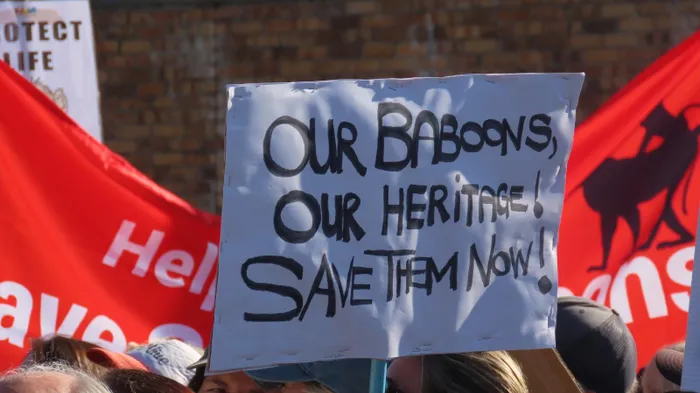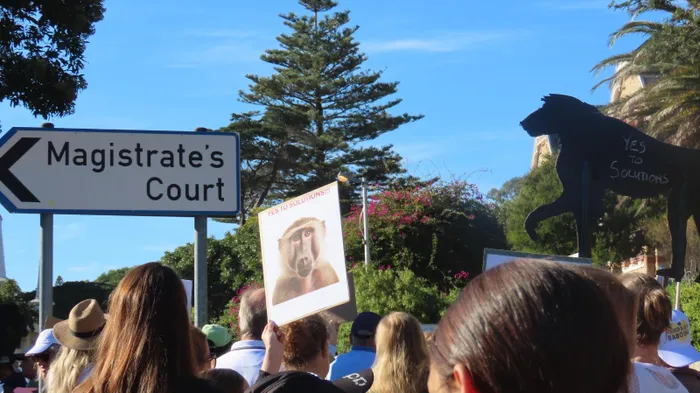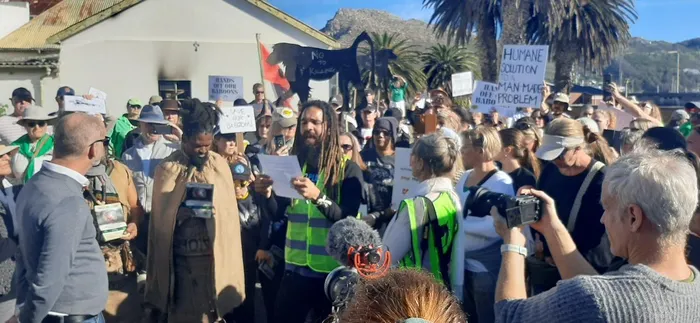Community rallies against the removal of Cape Peninsula baboons

A protest poster in Simon’s Town reflects public opposition to the proposed removal of five Cape Peninsula baboon troops, as conservationists call for non-lethal, long-term solutions.
Image: Debra Coull
Conservationists and animal rights supporters gathered in Simon’s Town on Saturday, July 19, to protest against the proposed removal of five baboon troops from the Cape Peninsula.
The peaceful march drew a strong turnout, with demonstrators calling for alternative solutions to protect the animals.
The protest was sparked by a recent announcement from the Cape Peninsula Baboon Management Joint Task Team (CPBMJTT) — a collaboration between SANParks, CapeNature and the City of Cape Town — outlining their updated management plan.
According to the CPBMJTT, the five splinter troops being considered for removal are CT1 and CT2 (north of Constantia Nek), Waterfall and Seaforth (splinter troops from Smitswinkel), and Da Gama4, which is active in Welcome Glen and Glencairn.
The task team said the proposed removals are in response to "limited access to natural foraging areas, poor troop health, and frequent human-wildlife conflicts."
They added that removal options include rewilding through translocation, relocation to existing or new sanctuaries, humane euthanasia, or a combination of these.
Lynda Silk, chairperson of the Cape Peninsula Civil Conservation (CPCC), attended the march and described the public response as a clear indication of growing concern.
“We saw a peaceful march and a strong turnout in Simon’s Town — a clear sign that people care deeply about the future of the Cape Peninsula’s baboons,” she said.
“Most people don’t attend marches — it’s not always their style, or they’re simply busy. But sometimes, stepping out matters.”

Activists voiced concern over the updated baboon management plan, calling for alternatives that prioritise coexistence.
Image: Debra Coull
Ms Silk warned that the current proposals could lead to the killing of a significant number of baboons.
“Right now, decisions are being made that could result in the killing of a quarter of Cape Town’s managed baboon population,” she said.
“These baboons are not alien intruders but residents of a rapidly shrinking wild world who were here long before our cityscape,” Ms Silk added.
She highlighted the broader ecological impact, saying that as urban development continues to fragment habitats, many species are quietly losing their homes — and their lives.
“The baboons are the face in the window, the messengers. Are we going to shoot the messenger, or adapt to live in a way that allows more of our wild things to survive our expanding human population?”
Jenni Trethowan, founder of the NGO Baboon Matters, also welcomed the public show of support. “We were enormously, enormously pleased with the support that the baboons received over the weekend at the peaceful march,” she said.
“It was absolutely incredible to see so many people from so many different communities coming out and walking peacefully through Simon’s Town. Everybody was carrying their homemade signs and slogans, and banners. I thought it was just incredible.”
She added that the message to authorities was loud and clear.
“I think it was a really strong message, and we sincerely hope that as they go into their decision-making processes, they do take into account the voice of the communities who sent a very strong message that they want solutions in place, and they don't want the baboons killed. So I hope that is carried forward.”

Activist Chad Cupido hands the letter of memorandum to the City of Cape Town, received here by Rob McGaffin
Image: Lynda Silk
As part of the protest, a memorandum was handed over to the local municipal office.
It called for urgent measures, including better public education and clear signage in baboon-prone areas, improved waste management systems, the installation of effective fencing, stricter enforcement of existing by-laws, and holding individuals accountable for feeding or harming baboons.
Rather than removals, Ms Silk believes the task team should focus on conservation infrastructure.
“Instead of removals, the new working partnership of the City, SANParks and CapeNature could be investing in buffer zones and ecological corridors that facilitate wildlife and people to coexist,” she said.
Such zones, she argued, would not only protect the baboons but also help South Africa meet its biodiversity goals.
“Healthy buffer zones can serve as Other Effective area-based Conservation Measures (OECMs), protecting biodiversity while benefiting nearby communities,” she said.
Ms Silk concluded that while there are real challenges in managing human-wildlife conflict, the removal — especially killing — of wildlife would be a “travesty” if other options had not been fully explored.
The CPBMJTT has previously stated that their strategic plan aims to “maintain a healthy, free-ranging baboon population in natural areas, with input from affected communities on local solutions.”
However, the growing public concern suggests that further dialogue and engagement may be needed before any final decisions are made.
Related Topics: